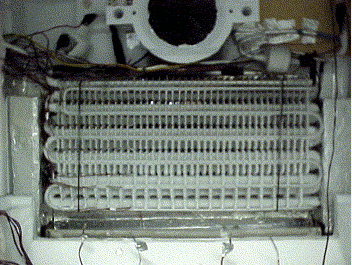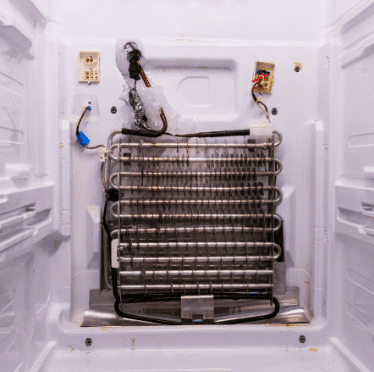My journey into the intricate world of refrigerator mechanics began when I found myself facing a perplexing issue: partially frosted evaporator coils. Little did I know that this seemingly innocuous problem would lead me on an adventure filled with discoveries about the inner workings of our trusty refrigerators. So, buckle up as I take you on a detailed and engaging exploration of the fascinating world of refrigerator evaporator coils.
What Are Refrigerator Evaporator Coils?
Imagine your refrigerator as a symphony of temperature control, and the evaporator coils as the virtuoso performers. These coils, like the unsung heroes of your kitchen, diligently maintain the perfect temperature by engaging in a dance of heat exchange. Nestled behind the freezer compartment, these coils play a pivotal role in keeping your ice cream frozen and your drinks refreshingly cool. Much like the gears in a clock, they work tirelessly to ensure your food remains fresh and your beverages stay chilled.

Understanding Partially Frosted Evaporator Coils
Ah, the enigma of partially frosted evaporator coils! It’s like discovering a magical glen where not all the trees are coated in frost, but just enough to create confusion. Partial frosting occurs when some coils are covered in a delicate layer of ice crystals while others remain untouched. This, my friends, disrupts the delicate balance of temperature control inside your refrigerator and can have far-reaching consequences.
So, how does this frosty phenomenon impact your fridge’s performance? Imagine wearing a fur coat in the middle of summer—it’s uncomfortable, unnecessary, and ultimately counterproductive. Partial frosting leads to imbalances in temperature, forcing your refrigerator to work harder to maintain the desired coldness. This overexertion not only hampers efficiency but also results in increased energy consumption. Who knew that a touch of frost could throw the entire refrigeration kingdom into chaos?
Common Causes of Partially Frosted Evaporator Coils
Now, let’s dive into the intriguing reasons behind the emergence of these partially frosted coils. My journey led me to encounter a cast of characters that contribute to this frosty spectacle:
- Inadequate Door Sealing: Imagine a door that doesn’t shut properly—your refrigerator’s worst nightmare. An improperly sealed door allows humid air to infiltrate the inner sanctum. Humidity, the silent saboteur, sneaks in and wreaks havoc, resulting in—you guessed it—partial frosting.
- Temperature Control Troubles: The thermostat, a small yet mighty guardian of temperature, occasionally fancies playing tricks. Fluctuations in temperature are like mood swings, and your refrigerator doesn’t appreciate moodiness. Such fluctuations lead to—you guessed it again—partial frosting.
- Food Overload Drama: Have you ever treated your refrigerator like Mary Poppins’ magical bag? Overloading it with warm or uncovered food causes uneven temperature distribution. This, unsurprisingly, leads to—you guessed it yet again—partial frosting. It’s a bit like throwing a massive party and expecting everyone to have a good time in the chaos.
- Dirty Condenser Coils: Condenser coils—the underappreciated workhorses of the refrigeration realm—often find themselves forgotten in a world of grime and dust. Neglecting them disrupts the heat exchange process, leading to—yep, you guessed it once more—partial frosting.
- Sneaky Refrigerant Leaks: Refrigerant, the lifeline of your refrigerator, can sometimes decide to play hide-and-seek. Leaks or insufficient refrigerant levels throw the cooling process out of whack, leading to—you guessed it yet again—partial frosting.

Troubleshooting and Solutions
Eager to restore harmony to the refrigeration kingdom, I embarked on a journey of troubleshooting. Armed with knowledge and determination, I set out to conquer the frosty foe. Here’s a comprehensive guide to rescuing your coils and preserving the peace in your fridge:
- Check That Seal: Ensuring your refrigerator door seals properly is the first line of defense. If it’s not closing snugly, it’s time to replace those gaskets and prevent unwelcome frosty guests.
- Tame the Thermostat: The thermostat’s mood swings can be managed. Maintain consistent thermostat settings to prevent temperature fluctuations that lead to—you guessed it—partial frosting.
- Food Tetris: Organize your refrigerator like a puzzle, but don’t overdo it. Avoid cramming it with warm or uncovered food, as this disturbs temperature equilibrium.
- Show Some Love to the Condenser Coils: Roll up your sleeves and embark on a cleaning spree for those condenser coils. Regular maintenance is the key to a frost-free existence.
- Call in the Pros: Refrigerant leaks are best handled by professionals. Attempting to fix them yourself can result in more harm than good. Reach out to experts who possess the knowledge and tools to tackle such intricate issues.

Preventive Measures
The timeless wisdom of “prevention is better than cure” holds true in the world of refrigeration. To keep your coils clear and your refrigerator frost-free, consider these preventive measures:
- Regular Maintenance Rituals: Incorporate coil cleaning and routine checks into your household chores. A little effort now saves you from frosty troubles later.
- Humidity Watch: Invest in a hygrometer to monitor humidity levels. Strike a balance between too much and too little humidity, as both can lead to frost-related problems.
- The Early Bird Advantage: Regular inspections act as your early warning system. Identifying and addressing potential issues before they escalate can save you from a frosty fiasco down the line.
- Energy Efficiency Champion: Well-maintained coils aren’t just about preventing frost; they also contribute to energy savings. You’ll notice the positive impact on your utility bills!
DIY vs. Professional Repair
While the thrill of DIY can be invigorating, it’s essential to exercise caution when handling refrigerators. Not all issues are meant to be tackled single-handedly. Safety should be your top priority. If you’re not comfortable handling refrigeration components, don’t hesitate to summon the experts. Professional repair services bring a wealth of experience, expertise, and specialized tools to the table, ensuring a successful resolution to your frosty dilemma.
Conclusion
And there you have it—the tale of my encounter with partially frosted evaporator coils. What seemed like a minor inconvenience unraveled into a captivating journey through the heart of refrigerator mechanics. Evaporator coils, those unsung heroes of temperature control, play a monumental role in preserving the freshness of your food and the efficiency of your refrigerator. Armed with knowledge about understanding, troubleshooting, and preventing frost-related issues, you too can navigate the complexities of refrigerator maintenance with confidence.
So, my fellow enthusiasts of all things refrigeration, the next time you spot a hint of frost in unexpected places, remember that your coils are trying to communicate with you. Listen, learn, and take action to ensure your refrigerator remains a haven of freshness and efficiency. After all, a well-maintained refrigerator is more than just a kitchen appliance—it’s a testament to your commitment to culinary excellence and household harmony. Stay frost-free, my friends, and spread the wisdom to others who might be facing their own frosty challenges!

